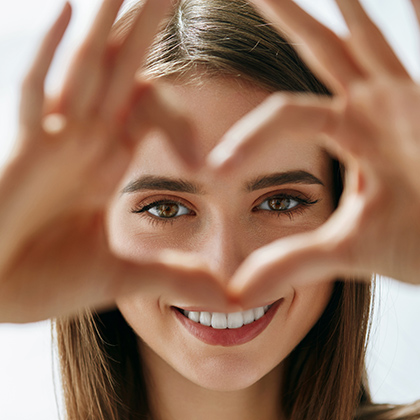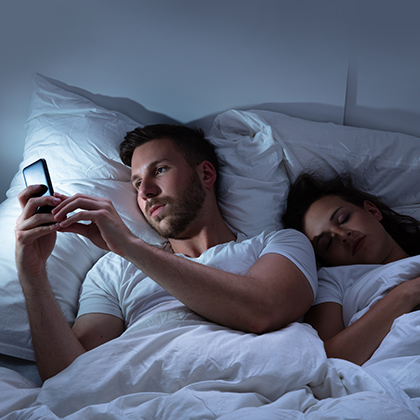
Much has been written in recent years about blue light and the effect it may have on eye health. But what is blue light, and can it really harm your vision? To help provide some clarity, we’ve put together this guide, breaking down the latest research and evidence.
What is blue light?
Light from the sun includes both visible and invisible light rays. Visible light contains red, orange, yellow, green and blue light rays, including many different shades of each colour, and when combined, the coloured rays create the ‘white’ light we see as sunlight. Visible light rays possess different amounts of energy and at differing wavelengths, with those that have long wavelengths containing less energy than those with short wavelengths. Blue light, for instance, is made up of short-wavelength, high-energy rays. A regular amount of exposure to blue light is fine for our eyes when mixed in with other colours, but excessive exposure to concentrated blue light rays may be potentially damaging.
Where does blue light come from?
As well as from the sun, many man-made objects also emit blue light, including fluorescent and LED lights, flat-screen televisions and computers, smartphones and tablet screens. However, the amount of blue light these devices produce is very small compared with the level coming from the sun. Since more and more adults and children are spending an increasing amount of time using digital devices, researchers have begun to look into the impact blue light may have on eye health. This is because, unlike UV rays which are blocked by the cornea and the lens, almost all blue light passes through these front structures of the eye to the retina, causing potential damage.i
Blue light and eye health: What the science says so far
Some studies have found that blue light may be potentially damaging to the retina, but since these focused either on laboratory-based cell culture experiments or were carried out on animals, more testing is necessary to draw solid conclusions.ii iii According to many experts, including the Association of Optometrists, there is to date no solid evidence that visible blue light is connected to eye disease.iv One review paper published in 2016 also confirms that short- and medium-term exposure to visible blue light has no impact on eye health, although researchers admit that additional studies are needed to decide either way.v
Blue light and age-related macular degeneration
You may also have read that blue light is linked to the development of an eye condition called age-related macular degeneration (AMD). However, again, there is as yet no strong science to suggest this is the case.
 In a presentation at London’s Royal Society of Medicine in October 2017, Professor Christopher Hammond, Chair of Opthalmology at King’s College London and consultant at Guy’s and St Thomas’ NHS Foundation Trust, stated that there overall there’s no evidence that blue light causes or accelerates AMD. Hammond stated that: “Damage from light is related to how bright that light is, and blue light emitted from LED screens is very dim, with the level estimated at one per cent of that which could cause damage. We therefore think that blue light from screens is harmless for the vast majority of the population.”i However, this is not to say that the effects may not be seen in the coming years, with Professor Hammond stating that it is too early to certainly say that blue screen light is completely harmless, especially in people with inherited retinal diseases or older people who’ve had cataract surgery.
In a presentation at London’s Royal Society of Medicine in October 2017, Professor Christopher Hammond, Chair of Opthalmology at King’s College London and consultant at Guy’s and St Thomas’ NHS Foundation Trust, stated that there overall there’s no evidence that blue light causes or accelerates AMD. Hammond stated that: “Damage from light is related to how bright that light is, and blue light emitted from LED screens is very dim, with the level estimated at one per cent of that which could cause damage. We therefore think that blue light from screens is harmless for the vast majority of the population.”i However, this is not to say that the effects may not be seen in the coming years, with Professor Hammond stating that it is too early to certainly say that blue screen light is completely harmless, especially in people with inherited retinal diseases or older people who’ve had cataract surgery.
Protecting your eyes from blue light
With all this conflicting evidence, it still might be beneficial to take precautions when it comes to protecting your eyes from blue light. If you use digital devices for prolonged periods of time you may have experienced sore, tired and dry eyes. This is believed to be caused by eye strain – although it’s also fair to say that, blue light could play some part in triggering eye strain. According to the American Academy of Opthalmology, the best way to protect your eyes against eye strain from blue light digital devices is to use the 20-20-20 rule.vi This means taking a 20-second break from your screen every 20 minutes and looking at something at least 20ft away, which can help the focusing muscles in your eyes relax. You could also try using artificial tears eye drops if your eyes feel dry from repeated screen-use. Eating a balanced diet is also considered helpful in keeping your vision healthy – find out more in our article on dietary considerations to improve your vision. Meanwhile, there’s also good evidence to suggest that blue light interferes with your sleep, so switch off your computer, smartphone and other devices at least an hour before going to bed. Find out more about this in our article. Discovering how blue light might be disturbing your sleep could be the step to a more peaceful night’s rest.
Taking steps to protect your vision at any age should help to keep them healthy for longer. To discover even more ways of keeping your eyes ticking over, why not visit our Vision Health Hub, where you’ll find a number of helpful articles.
References:
-
Royal National Institute of Blind People. Can blue light cause AMD? (2017). Available online: https://www.rnib.org.uk/nb-online/blue-light-amd
-
Davies, S., et al. Photocytotoxicity of lipofuscin in human retinal pigment epithelial cells. Free Radic Biol Med. 2001 Jul 15. ;31(2):256-65. Available online: https://www.ncbi.nlm.nih.gov/pubmed/11440838?dopt=Abstract
Sparrow, J.R., Miller, A.S., Zhou, J. Blue light-absorbing intraocular lens and retinal pigment epithelium protection in vitro. J Cataract Refract Surg. 2004 Apr. ;30(4):873-8 -
Seko, Y., Pang, J., Tokoro, T., Ichinose, S., Mochizuki, M. Blue light-induced apoptosis in cultured retinal pigment epithelium cells of the rat. Graefes Arch Clin Exp Ophthalmol. 2001 Jan. ;239(1):47-52. Available online: https://www.ncbi.nlm.nih.gov/pubmed/11271461
Ham, W.T., Ruffolo, J.J., Mueller, H.A. & Guerry, D.The nature of retinal radiation damage: dependence on wavelength, power level and exposure time. Vision Research, Volume 20, Issue 12. 1980. Pages 1105-1111. Available online: https://www.sciencedirect.com/science/article/pii/0042698980900474 -
Association of Optometrists. Visible Blue Light. (2017). Available online: https://www.aop.org.uk/advice-and-support/policy/position-statements/visible-blue-light
-
Tosini, G., Ferguson, I., Tsubota, K. Effects of blue light on the circadian system and eye physiology. Mol Vis. 2016. 22: 61–72. Available online: https://www.ncbi.nlm.nih.gov/pmc/articles/PMC4734149
-
American Academy of Opthamology. Should you be worried about blue light? (2017). Available online: https://www.aao.org/eye-health/tips-prevention/should-you-be-worried-about-blue-light
Related Posts?
Disclaimer: The information presented by Nature's Best is for informational purposes only. It is based on scientific studies (human, animal, or in vitro), clinical experience, or traditional usage as cited in each article. The results reported may not necessarily occur in all individuals. Self-treatment is not recommended for life-threatening conditions that require medical treatment under a doctor's care. For many of the conditions discussed, treatment with prescription or over the counter medication is also available. Consult your doctor, practitioner, and/or pharmacist for any health problem and before using any supplements or before making any changes in prescribed medications.

Christine
Christine Morgan has been a freelance health and wellbeing journalist for almost 20 years, having written for numerous publications including the Daily Mirror, S Magazine, Top Sante, Healthy, Woman & Home, Zest, Allergy, Healthy Times and Pregnancy & Birth; she has also edited several titles such as Women’ Health, Shine’s Real Health & Beauty and All About Health.
View More



